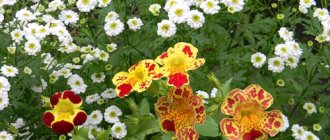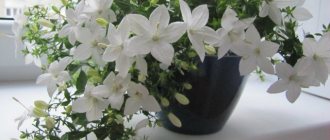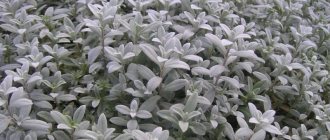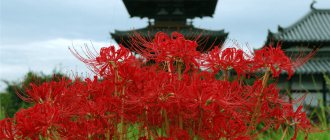Care, color combination
As we have said many times, cleome is a godsend among flowers; it perfectly performs a decorative function and requires minimal care. All she needs is:
Cleome spider flower
- maintain a temperature of at least 15 degrees, this is necessary for good development and growth;
- plant in a well-lit place where the soil warms up best, although it is a hardy plant, try to plant in a place where there are no strong winds;
- do not over-moisten the soil, cleome is a heat-resistant plant, even in extreme heat it will have a fresh look and will withstand the scorching rays of the sun much longer than many other flowers, but it will not tolerate stagnation of water in the soil;
- throughout the summer it needs to be fed 2 or 3 times, the first feeding is done two weeks after planting, the second feeding is necessary at the beginning of flowering, the third can be done at any time if the flower requires it, but usually it is no longer needed;
- pull out the weeds.
Without a doubt, cleome is a very beautiful flower, but many people often wonder how to combine it with other flowers and in which part of the garden it is better to plant it so that everything is combined and harmonious.
But the answer is simple: it looks great anywhere - you can plant it in the background to hide inappropriate and ugly areas in the territory, you can plant it in the center of low-growing plants, it will look great as a single plant and will not spoil the view.
You can focus on color, namely, plant monochromatic plants, and plant our flower next to them, it will look like bright, fabulous spots. Cleome looks great everywhere
Cleome looks great everywhere
Perhaps you have a fragrant garden and you are in doubt about the smell, this is also not a problem, its smell is pleasant and will not overpower other aromas, so you can safely plant it next to any flowers.
She may not have received universal recognition, but look at the cleomes of the photograph, or in person, I think you are unlikely to remain indifferent.
Sowing seedlings in open ground
Cleome is planted in open ground after the period of return frosts has passed. The recommended transplant time is the end of May or the beginning of June.
Cleome must be planted in a well-lit area in neutral acidity soil. The area should be well protected from the wind. It is recommended to dig up soil that is too poor and add compost in the amount of one bucket per 1 square meter. m.
Before planting, it is advisable for plants to undergo a hardening procedure lasting 1 week. In addition, for good seedling survival, it should be treated with stimulants:
- Epin-extra;
- specialized fertilizer Tsitovit.
Important! When treating plants with these drugs, you should strictly follow the instructions. Exceeding their concentrations can destroy the plant.
Planting seedlings in open ground is done together with a peat pot (or with a lump of earth if using another individual container) so as not to damage the root system of the cleome. Plants are planted in a square pattern or in a checkerboard pattern with distances of 50-70 cm both between plants and between rows. This will avoid excessive thickening of the planting and make it difficult for pests and diseases to spread from bush to bush.
Planted plants must be watered at the root, avoiding water getting on the leaves. To improve survival rate at this stage, it is allowed to water young cleomes with a humate solution.
To achieve rapid flowering, cleome should be properly cared for:
- Provide infrequent but abundant watering. They will be especially important in hot weather.
- Fertilize with the same frequency - 15 days. In this case, use complex fertilizer in the full recommended concentration.
- During budding, it is necessary to feed the plants with a Zircon solution at a concentration of 10 mg per bucket of water.
- Regularly remove weeds and loosen the soil after watering. This procedure can be avoided if you mulch the soil around the bush with straw.
With proper care, seedling cleome begins to bloom in the second decade of June.
Growing cleome
Eucharis flower.
Description, features, types and care of eucharis Hello, dear friends!
Cleome spinosa is called a “spider plant” in Russia, and a “spider plant” (Spinenpflanze) in Germany. The decorative crop received such an unusual nickname for the external resemblance of flowers to a spider. Although the plant has been used in floriculture since the first half of the 19th century, it is rarely grown in temperate climates. So, let's talk about how to grow cleome
prickly.
Biological features
In the tropics, cleome grows as a perennial subshrub, but in central Russia it can only be grown as an annual crop.
The spider plant grows up to 90 cm tall and has powerful stems branching at the top. Their lower part becomes lignified, and this feature gives the plant greater stability. The stems and large palmate leaves have rare spines, for which the species name is given.
The plant is highly decorative due to its large (up to 20 cm in diameter) racemose inflorescences formed by numerous flowers 2-3 cm in size. The colors of the inflorescences can be different: white, yellow, pink, red. The structure of the flowers is asymmetrical and very unusual. The four petals are collected on one side of the flower, and the long stamens and pistil are on the other. The “spider plant” blooms from June until the first frost. Cleome has a strong, unique aroma. It is not emitted by flowers, but by numerous glandular hairs scattered on the stems and leaves.
Agricultural technology
Growing prickly cleome in your own garden is not particularly difficult. The plant is unpretentious and thrives in Russian summer conditions.
Growing seedlings
In early March, cleome seeds are sown in seedling boxes. The substrate is prepared from humus and garden soil, taken in equal quantities. A little ash and sand are added to the mixture. To speed up germination, it is recommended to pre-soak the spider seeds in Epin-Extra. The sown seeds are covered with compost on top.
Shoots, which usually appear after 10-20 days, require regular spraying. In the two-leaf phase, young plants dive into separate containers. Moisten the substrate moderately as it dries.
Transplantation to a permanent place
The most suitable time for transplanting seedlings into the garden is the end of May-beginning of June, when the threat of late frosts has already passed. Sunny, dry areas are suitable for this crop. Before planting, it is better to add a little complex fertilizer (2 tablespoons per 1 sq.m.) and compost to the soil of the flower garden. It is recommended to spray the seedlings with the same stimulant that was used for the seeds.
When planting young plants, you need to remember that they grow tall and spreading. Therefore, a spacious place is allocated for the cleome. A suitable planting pattern is 40x50 cm.
Caring for flowering plants
Cleome is very responsive to mineral fertilizers intended for flowering crops. Supplemental nutrition should be provided once every 3-4 weeks. During the season, the spiderling needs to be fed at least 2-3 times. Adult plants, as well as seedlings, need regular but moderate watering. They tolerate drought much more easily than excessive moisture.
Use in design
Spiderwort is a very original and spectacular plant. It is beneficial to use in any decorative plantings: group compositions, mixborders, hedges. Cleome also looks good as a tapeworm.
The plant can also be used for cutting. To make flowers last longer, it is recommended to cut them at sunset. At the same time, the thorns are removed from the stems at the base of the leaves and the bouquet placed in water is left in the fresh air until the morning. The next day, cleome can be brought into the house.
Now you know how to grow cleome
prickly. Be sure to try it! This plant not only brings a “touch” of beauty to the design of the room, but also purifies the air. It was discovered that the “spider plant,” even in a bouquet, is capable of absorbing cigarette smoke, carbon dioxide and other harmful impurities. See you later, friends!
Description of Hassler's cleome ↑
Name: Hassler's Cleome (Cleome hassleriana) Category: In zones of Russia it is grown as an annual plant, but in zones 10-11 it is grown as a perennial. Type: erect stem, on top of which is a spherical inflorescence. The spider bushes well and has, although shallow, powerful roots.
Leaves: light green. They are smaller at the top and large at the bottom, shaped like a chestnut. There are thorns hidden at the bases of the leaves, which is why cleome is nicknamed prickly. Plant height: 60-90 cm Inflorescence color: pink, white and its shades, purple and lavender. Flowering time: long and abundant. It begins to bloom in June-July, inflorescences appear and bloom throughout the summer, until autumn.
Another feature of the plant is its specific aroma, which not everyone finds pleasant, but which attracts many bees. This smell comes from small sticky hairs that cover the entire plant.
Planting and growing
Cissus flower. Description, features, types and care of cissus
Planting of cleome flowers is carried out using seeds, they are sown in special boxes for seedlings, for this it is necessary to prepare the soil in advance, it should consist of two parts of garden soil, two parts of humus and one part of sand. Wood ash must be poured on top of the earthen mixture.
In the prepared soil, to a depth of 1 cm, we sow the seeds. The first shoots will occur in two weeks, but to improve the process, sprinkle the sown seeds with compost.
After planting the cleome, place the boxes in a warm, well-lit room; if there is little light, create artificial lighting. Watering is needed as the soil dries out; there is no need to over-moisten it, but there is also no need for drought, although it is more resistant to it.
Some tips for planting:
- try to plant in boxes in mid-March, then the flower will bloom on time;
- cover the boxes with film or glass, then the temperature will be better maintained;
- To make the seeds germinate faster, soak them in a special growth stimulant solution before planting.
After the cleome seedlings have become stronger, they can be planted in open ground. Naturally, this should be done when there is no longer frost.
After the cleome seedlings have become stronger, they can be planted in open ground.
Do not forget that this is a plant with a good root system, and in order for it to develop well, it is necessary to maintain a distance when planting, preferably a meter, in this case the bushes will grow well, develop normally and will not interfere with each other.
The main thing for a flower is good lighting, and the plant is resistant to weather changes, types of soil, and infrequent watering; it is better to water it infrequently than to over-water it.
Cleome is not difficult to grow, it is well suited for any garden and flower bed, it does not cause any trouble, as it is a non-capricious plant.
How to grow cleome seedlings
If cleome is planted in the fall, it is recommended to plant it in open ground. It is necessary to understand that the growing season of the plant is very long. Therefore, cleomes grown naturally (with seeds overwintering in the ground) will develop for a relatively long time, and their flowering will be late.
You can speed up this process by about a month if you use autumn planting of cleome using seedlings. Next, growing cleome from seeds at home will be discussed in more detail.
When to sow cleome for seedlings
It is best to plant cleome seedlings in late February or early March. Earlier dates are not recommended, since seedlings can rapidly grow even before the time when they can be transplanted into open ground. The transplantation process will be very difficult.
Planting seeds for seedlings later will not give any gain in time, since the time of hatching of the “seedling” seeds will coincide with the awakening of the seeds planted last year.
Soil preparation
The soil for cleome should have neutral or slightly acidic acidity. Its approximate composition is as follows:
- turf soil - 2 parts;
- humus - 2 parts;
- river sand – 1 part.
Instead of humus, you can use peat, and it is recommended to add a little wood ash to the soil.
Preliminary antiseptic treatment for the soil is not required, since cleome has good resistance to fungal diseases.
To sow cleome, it is necessary to use a deep container (at least 15 cm). It is preferable to use rectangular seedling boxes that can be easily covered with film or glass. It is necessary to pour soil into the container so that its level does not reach the edge of the container by about 1.5-2 cm.
Seed preparation
To speed up seed germination and increase the percentage of germination, it is advisable to pre-treat them by soaking them in growth stimulants.
12 hours before sowing the seeds, they should be soaked in Epin's solution and kept there all the time until planting in the ground. The concentration of the solution should be low: two drops of Epin are enough for a glass of boiled warm water.
Attention! It is recommended to use the drug Zircon instead of Epin - a universal regulator of root formation, growth, flowering and fruiting. The drug concentration and treatment time are similar to those described above.
There is no need to dry the seeds after treatment with stimulants; they are immediately sown in the ground.
Sowing seeds
Sowing cleome seeds for seedlings is carried out as follows:
- The seeds are evenly sprinkled onto the surface of the previously prepared soil.
- The seeds are sprinkled on top with a layer of the same soil 1-1.5 cm thick. Instead of soil, it is possible to use a layer of compost of the same thickness.
- This layer is additionally sprinkled with a small amount of wood ash on top.
- Provide moderate watering.
- The seedling container is covered with glass or plastic film to create a greenhouse effect.
After planting and watering, the box with seedlings is placed in a warm and bright place. The ideal option is the window sill of southern windows. However, you should not place the box too close to the window, so as not to expose the plant to drafts.
Seedling care
Approximately 15-20 days after planting, the first shoots appear. As soon as this happens, the young shoots should be provided with additional lighting in the form of LED lamps. The total daylight hours for seedlings should be at least 12 hours a day.
You can remove the cover immediately after about 80% of the seeds have sprouted, but it is better to do this when the tallest shoots reach its level.
Watering is carried out as the soil dries out. It is advisable not to use a spray bottle, but to carefully pour water into the seedling box with a thin stream of water from a watering can, avoiding washing out the soil.
Plants are picked into individual containers when they have 2 true leaves. Peat pots with a height of at least 15 cm are used as individual containers. Plants are buried in the soil up to the cotyledon leaves.
The first feeding of seedlings is carried out 15 days after picking. For this, complex mineral fertilizer for flowers is used in a concentration 2 times less than indicated on the package. Subsequent feedings are carried out every 15 days. The fertilizer concentration remains the same.
Pots with young cleomes should be turned with different sides towards the light source so that the stem is even.
Important! Despite the fact that cleome seedlings grow very slowly, you should not “accelerate” them with fertilizers, as this can lead to burns of the plant’s root system.
Davallia description and types
Evening primrose flower cultivation and care, photo
Davallia (lat. Davallia) received its scientific name from the name of the Anglo-Swiss botanist Edmund Davalla. It is a fast-growing epiphytic herbaceous perennial that belongs to the genus of the same name, which contains approximately 40 species.
In the wild, it is found in tropical countries of Asia, China, Japan, Polynesia, the Canary Islands and the islands of Fiji, Java.
Did you know? Dawallia, the only fern with roots outward, besides the “rabbit’s feet”, is also called “squirrel’s feet”, “deer’s foot”, “spider fern”.
It has a thick creeping fleshy rhizome that grows on the soil surface. The base is covered with scales and densely covered with silvery down. Root-foots can grow up to 90 cm in length.
The fronds of this fern are predominantly triangular, bright green, finely pinnate, dissected, and drooping. Reaches a height of 15-20 cm.
Many species of Davallia are grown indoors (greenhouses) and in indoor pots.
In greenhouses, the most common inhabitants are Davallia bullata, Davallia pentaphylla, Davallia dissecta, Davallia truncatula, Davallia trichomanoides, Davallia mariesii.
In indoor conditions, the hare's foot plant is most often grown as a hanging plant - this is how its exoticism and beauty can be emphasized. It is also used to compose epiphytic compositions.
Among the indoor species, the most popular are Canarian Davallia (Davallia canariensis), Davallia bullata Wall, Davallia solida.
Types of cleome
Nowadays there is no shortage in flower shops, and you can buy cleome or its seeds very easily, but you should correctly focus on plant varieties in order to understand which one is best suited to certain growing conditions and climate.
Today we know the following varieties of cleome:
- Cleome Champagne splash, Hasler's cleome;
- Cleome colored fountain and cleome white;
- Cleome Cherry Queen, as well as varieties “Violet Queen”, “Helen Cambell”, “Rosakonigin” and “Gigant Pink Queen”.
What does clerodendrum look like and where does it come from?
Clerodendrum is a genus belonging to the Verbenaceae family. It has significant diversity. Among its more than 400 representatives there are trees, low shrubs, vines that shed their leaves for the winter and evergreen species.
Its homeland is tropical rainforests around the world. It is found in Southeast Asia, Oceania, Africa. Slightly less common in South and Central America.
The name of the plant is translated from Greek as “tree of fate.” This is due to the old belief that it can change your life for the better. It is not known exactly where the legend came from, but most consider the island of Java to be its homeland.
Where climate permits, clerodendrum is widely used in landscape design.
Flower growers sometimes, meaning clerodendrum, say “innocent love.” Perhaps this popular name is associated with the combined red and white flowers.
In nature, clerodendrum grows up to 3–5 m tall. But you can “shorten” it to a potted plant, up to about 1.5 m. Only regular formative pruning of the shoots will be required.
Most clerodendrums do not have a clearly defined stem. Instead, they have many shoots of approximately equal length and thickness that quickly become woody at the base. If there is still a trunk, it is most often hollow. In nature, ants will almost inevitably settle inside.
Clerodendrum leaves, depending on the type, are located opposite each other or in groups of three. Their shape is always heart-shaped, with a pointed tip. The length, depending on the type, is 7–15 cm. The surface of the leaf is dark green, uneven, and evokes associations with a quilt. “Bloats” are located between the veins. The edge can be either smooth or jagged. The leaves are thin to the touch, but dense and harsh.
Even non-flowering clerodendrum looks quite impressive
The main thing that attracts gardeners to clerodendrum is the flowers. In suitable conditions, the plant blooms very profusely, literally becoming covered with inflorescences in the form of a shield or panicle. Each inflorescence consists of 4–20 flowers. They are small (2–3 cm in diameter), but this is more than compensated by quantity.
In nature, the plant blooms from mid-spring to autumn. But at home, especially in winter gardens, greenhouses, greenhouses, you can achieve almost year-round flowering. Most species have a very special smell of flowers and leaves, characteristic only of this clerodendrum.
The fruit of the clerodendrum is similar to a berry, although from a botanical point of view it is a drupe. There are always 4 nests in it, in which 2–4 seeds ripen.
If you do not need clerodendrum seeds, cut off the faded inflorescences
A non-flowering plant can also be used in design. This is an excellent material for a trellis. It grows very quickly along guides (supports, wire), creating a continuous carpet of leaves.
Collection of cleome seeds
Cleome is propagated exclusively by seeds, so at the end of the season the seeds must be collected and prepared for planting. After the flowering process ends, green pods appear in place of the flowers, in which the seeds begin to ripen.
Attention! To avoid uncontrolled propagation of cleome by self-sowing, it is important not to miss the time of seed ripening.
Seed ripening lasts 1-1.5 months. Since the flowering time of cleome can be extended from June to August, it is necessary to monitor the condition of the seed pods to avoid their spontaneous sowing.
As they ripen, the color of the boxes will change from green to yellow-green. As soon as the color change becomes visually noticeable, it is recommended to place the pods in gauze bags. You can place several pods in one bag at once.
It is recommended to regularly check the condition of the seeds by opening one pod at a time and inspecting the seeds. Since there will be a lot of pods on the cleome, this will have virtually no effect on the amount of seed.
Fully ripe seeds will be 1.5 mm in diameter and brown in color. As soon as the seeds acquire the desired condition, all the pods from the plant can be cut off and the seed material can be extracted from them. The appearance of ripened cleome seeds is shown in the photo:
What does a spider mite look like?
Spider mites are almost invisible on indoor plants. This is a tiny spider, 0.5-1 mm in size, whose body is colored brown, green, brown or gray. It causes damage to plants during its feeding. Unfortunately, adult mites and their larvae feed on cell sap, which they extract by piercing leaf blades with their jaws. The leaves first become covered with small transparent dots, then turn yellow completely, and then dry out and fly off. In this case, naturally, the plant stops developing normally, photosynthesis deteriorates and, in advanced cases, its death may occur.
And here is our main character - a spider mite under a microscope
Care
Proper care includes several nuances, namely:
- air temperature and humidity;
- lighting;
- watering;
- soil fertilization;
- characteristics of the plant.
The Champagne Splash flower grows at temperatures from fifteen to twenty degrees, so the plant is planted in November or December, and the humidity should be moderate.
Cleome loves light, so you need to plant it where there is a lot of light and direct sunlight. But in extreme heat, the flower may wilt. In the hot season, the flower should be shaded, protecting it from the abundant sun.
It is not necessary to water the flower too often; this can lead to flooding of the plant, causing it to stop growing. Watering should only be done when the soil is very dry. The plant has certain characteristics:
- disease resistance;
- lack of need for shelter for the winter;
- thermophilicity, intolerance of extreme cold.
In case of extreme heat or frost, to protect the plant, it can be treated with Epin solution at the rate of one milliliter of solution per five liters of water.
Indoor flower cleome
Usually this unusually beautiful annual is planted in garden plots. But if you follow certain rules for caring for this plant, then an indoor “champagne splash” flower may well become an interior decoration. Following simple agricultural practices allows you to admire its amazing flowers for several years.
To do this, it is necessary to bring the conditions of its maintenance closer to natural ones. Considering that the homeland of cleome is the tropics, it should be placed on the sunniest windowsills, and the air temperature in the apartment in the summer should not fall below 20⁰C. In winter, coolness is required - about 15⁰C. Regular spraying will create the moisture necessary for a tropical plant.
Otherwise, “champagne spray” flowers are quite unpretentious and hardy. Planting and caring for them does not cause any particular difficulties even for novice gardeners. It is enough to provide regular watering and fertilizing with regular fertilizer for indoor flowering plants.
Growing seedlings
Cleome is one of those ornamental plants that can only be propagated using seeds. Collected or purchased seed material can be sown directly into the ground or used to produce seedlings.
Sowing
In order to grow healthy and strong seedlings, it is necessary to begin agricultural work at the end of winter. Seeds can be planted in special planting containers filled with a nutrient mixture, or in peat containers. You can use ready-made soil for planting or prepare a soil mixture at home. To independently prepare the substrate, you need to mix humus, turf soil and river sand in equal proportions. Before sowing seeds, they must be soaked in a growth accelerator, which will not only increase the germination rate, but also protect the plants from various diseases.
Popular varieties of cleome
Domestic gardeners have access to only two varieties of exotics - spiny cleome and Hassler's cleome. They have practically no differences, so they are called by a common name, and to obtain new varieties they are crossed with each other. The difference between the crop varieties is only in the shade of the inflorescences:
- Hellen Campbell - white flowers;
- Pink Queen - pink inflorescences;
- Giant Pink Cusen - large flowers, painted in purple tones;
- Sparkler Lavender - pale lilac inflorescences;
- Cherry Queen - carmine-red petals;
- Champagne splashes - color from white to pink;
- Colorful waterfall - white, pink and dark pink petals.
Attention! All parts of the cleome have small glands that emit a specific odor that many may find unpleasant. For this reason, it is better not to plant flowers near your home or vacation spots. But bees, on the contrary, really like the unusual aroma, so it can promote pollination.
Prices for cleome seeds
Features of care
The cleome flower is not capricious, so it is easy to care for; this is one of the advantages of this plant culture. It is recommended to water it in moderation, since cleome does not like overly moist soil. Natural precipitation is often sufficient. In dry weather, the plant is moistened abundantly, but infrequently.
When flowering has not yet begun , you can feed with mineral fertilizers twice a month. It is necessary to carry out root feeding. For weakened plants, you can use the spraying method. For example, a solution of cycron is suitable; it is used before the formation of buds. This method will speed up the onset of flowering. Every time after watering, the soil must be loosened and weeds removed.
Tall bushes should be tied to a support, as they can be broken by the wind. To do this, you need to drive pegs along the edges of the flowerbed and stretch a rope. Ripe pods of the plant open on their own, so it is necessary to cut them off in time to prevent spontaneous planting of seeds. The very first inflorescences are saved for seeds.
Procurement of seeds
Cleome reproduces exclusively by seeds. They are able to remain viable for up to 3 years.
The seeds are collected in the fall, when the pod ripens and opens easily when pressed. You can determine its degree of maturity by its color - it becomes darker. You cannot keep the seeds on the plant, because the pods, when ripe, burst and all their contents end up on the ground. To prevent this, you can place some of them in gauze bags in advance. Then, when the pod opens, the seeds will not fall on the ground, but will remain in the bag.
Using cleome
Magnificent cleome will decorate your front garden, flower bed and lawn. tall plants in the center, and small ones around them to cover the thorny stems. Low varieties are also suitable for decorating paths. All crops can be grouped in the middle of the flower garden. It can also be used to create landscape design in a rustic style.
Magnificent bushes go well with green beds and coniferous trees. Good combinations for cleome include: delphinium, echinacea, asters, marigolds, Salvia, rudbeckia, helenium and physiostegia. But for the composition it is important to take into account the individual characteristics of each variety and its height. Cleome should be used as an individual bouquet or as part of an ikebana.
Cleome flower
Cleome care
It is not at all complicated and consists of timely watering, fertilizing and weeding.
Watering
Cleome should be watered only in hot and dry weather, but you should not delay watering in such conditions - the flower does not tolerate severe drying out of the soil very well.
Top dressing
Fertilizers are applied at the root; the most suitable of them are fertilizers such as “Fetika”. Weakened plants are fed by foliar feeding. If the seedlings have been well fed and the soil is fertile, then the flowerbed may no longer need to be fertilized this year.
You can speed up the onset of budding by using the drug “Zircon” in an aqueous solution.
Types and varieties
More than 100 species of cleome can be found in natural habitats, but only some varieties of annuals and perennials, which are widely used in landscape design, grow in artificial conditions. Experts recommend paying attention to the following varieties:
- prickly (Spinosa);
- Hassleriana.
The most popular varieties of prickly cleome and their colors:
- “Cherry Queen” – violet, lilac;
- “Helen Campbell” – snow-white;
- "Rosenkonigin" - peach;
- "Pink Queen" - pink;
- "Rose Queen" - soft pink;
- “Violet Queen” – lilac, dark blue;
- "Matilda" - multi-colored;
- “Golden sparkler” – lemon, gold;
- “Giant Pink Kyusen” – dark pink;
- “Colored fountain” – multi-colored;
- "Sparklar Lavender" - soft purple.
Varieties of Hassler's cleome and their colors:
- “Splashes of champagne” – pearl, soft lilac;
- "Kelly Rose" - pink, lilac.
The Queen series deserves special attention, which includes such varieties as “Cherry Queen”, “Pink Queen”, “White Queen” and Violet Queen.
Growing from seeds
Since the growing season of the plant is quite long, it is better to use the seedling growing method, but some gardeners prefer to sow the seeds directly in the garden plot. Flowering in this case will occur later, but the method requires minimal labor and time.
Planting seeds in open ground
Regardless of how cleome will be grown, the land for planting should be prepared in advance, around April. To plant plants, choose an area with good lighting and drainage, and the groundwater should be deep enough - the flower tolerates temperature changes well, but does not like stagnant moisture. The soil needs to be dug up, weeds removed, organic matter (compost is best) or complex fertilizers - no more than 2 tablespoons per square meter. The procedure is carried out on the eve of winter (last weeks of November - early December).
Table 1. Step-by-step instructions for planting cleome seeds in open ground.
Sources:
https://chto-posadit.ru/tsvetok-kleoma-vyrashhivanie-iz-semyan-posadka-i-uhod-v-otkrytom-grunte-kogda-seyat-na-rassadu/ https://stroy-podskazka.ru/ cvety/kleoma/ https://teplica-exp.ru/kleoma-vyrashhivanie-iz-semyan/











